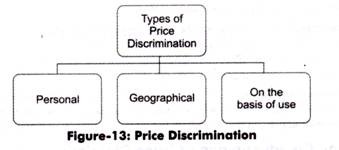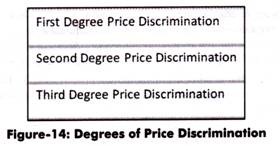In monopoly, there is a single seller of a product called monopolist. The monopolist has control over pricing, demand, and supply decisions, thus, sets prices in a way, so that maximum profit can be earned.
The monopolist often charges different prices from different consumers for the same product. This practice of charging different prices for identical product is called price discrimination.
According to Robinson, “Price discrimination is charging different prices for the same product or same price for the differentiated product.”
According to Stigler, “Price discrimination is the sale of various products at prices which are not proportional to their marginal costs.”
ADVERTISEMENTS:
In the words of Dooley, “Discriminatory monopoly means charging different rates from different customers for the same good or service.”
According to J.S. Bains, “Price discrimination refers strictly to the practice by a seller to charging different prices from different buyers for the same good.”
Let us learn different types of price discrimination.
Types of Price Discrimination:
ADVERTISEMENTS:
Price discrimination is a common pricing strategy’ used by a monopolist having discretionary pricing power. This strategy is practiced by the monopolist to gain market advantage or to capture market position.
There are three types of price discrimination, which are shown in Figure-13:
The different types of price discrimination (as shown in Figure-13) are explained as follows:
ADVERTISEMENTS:
i. Personal:
Refers to price discrimination when different prices are charged from different individuals. The different prices are charged according to the level of income of consumers as well as their willingness to purchase a product. For example, a doctor charges different fees from poor and rich patients.
ii. Geographical:
Refers to price discrimination when the monopolist charges different prices at different places for the same product. This type of discrimination is also called dumping.
iii. On the basis of use:
Occurs when different prices are charged according to the use of a product. For instance, an electricity supply board charges lower rates for domestic consumption of electricity and higher rates for commercial consumption.
Degrees of Price Discrimination:
Price discrimination has become widespread in almost every market. In economic jargon, price discrimination is also called monopoly price discrimination or yield management. The degree of price discrimination vanes in different markets.
Figure-14 shows the degrees of price discrimination:
These three degrees of price discrimination (as shown in Figure-14) are explained as follows:
i. First-degree Price Discrimination:
Refers to a price discrimination in which a monopolist charges the maximum price that each buyer is willing to pay. This is also known as perfect price discrimination as it involves maximum exploitation of consumers. In this, consumers fail to enjoy any consumer surplus. First degree is practiced by lawyers and doctors.
ii. Second-degree Price Discrimination:
ADVERTISEMENTS:
Refers to a price discrimination in which buyers are divided into different groups and different prices are charged from these groups depending upon what they are willing to pay. Railways and airlines practice this type of price discrimination.
iii. Third-degree Price Discrimination:
Refers to a price discrimination in which the monopolist divides the entire market into submarkets and different prices are charged in each submarket. Therefore, third-degree price discrimination is also termed as market segmentation.
In this type of price discrimination, the monopolist is required to segment market in a manner, so that products sold in one market cannot be resold in another market. Moreover, he/she should identify the price elasticity of demand of different submarkets. The groups are divided according to age, sex, and location. For instance, railways charge lower fares from senior citizens. Students get discount in cinemas, museums, and historical monuments.
ADVERTISEMENTS:
Necessary Conditions for Price Discrimination:
Price discrimination implies charging different prices for identical goods.
It is possible under the following conditions:
i. Existence of Monopoly:
Implies that a supplier can discriminate prices only when there is monopoly. The degree of the price discrimination depends upon the degree of monopoly in the market.
ii. Separate Market:
ADVERTISEMENTS:
Implies that there must be two or more markets that can be easily separated for discriminating prices. The buyer of one market cannot move to another market and goods sold in one market cannot be resold in another market.
iii. No Contact between Buyers:
Refers to one of the most important conditions for price discrimination. A supplier can discriminate prices if there is no contact between buyers of different markets. If buyers in one market come to know that prices charged in another market are lower, they will prefer to buy it in other market and sell in own market. The monopolists should be able to separate markets and avoid reselling in these markets.
iv. Different Elasticity of Demand:
Implies that the elasticity of demand in the markets should differ from each other. In markets with high elasticity of demand, low price will be charged, whereas in markets with low elasticity of demand, high prices will be charged. Price discrimination fails in case of markets having same elasticity- of demand.
Advantages and Disadvantages of Price Discrimination:
ADVERTISEMENTS:
A monopolist practices price discrimination to gain profits. However, it acts as a loss for the consumers.
Following are some of the advantages of price discrimination:
i. Helps organizations to earn revenue and stabilize the business
ii. Facilitates the expansion plans of organizations as more revenue is generated
iii. Benefits customers, such as senior citizens and students, by providing them discounts
In spite of advantages, there are certain disadvantages of price discrimination.
ADVERTISEMENTS:
Some of the disadvantages of price discrimination as follows:
i. Leads to losses as some consumers end up paying higher prices
ii. Involves administration costs for separating markets.

